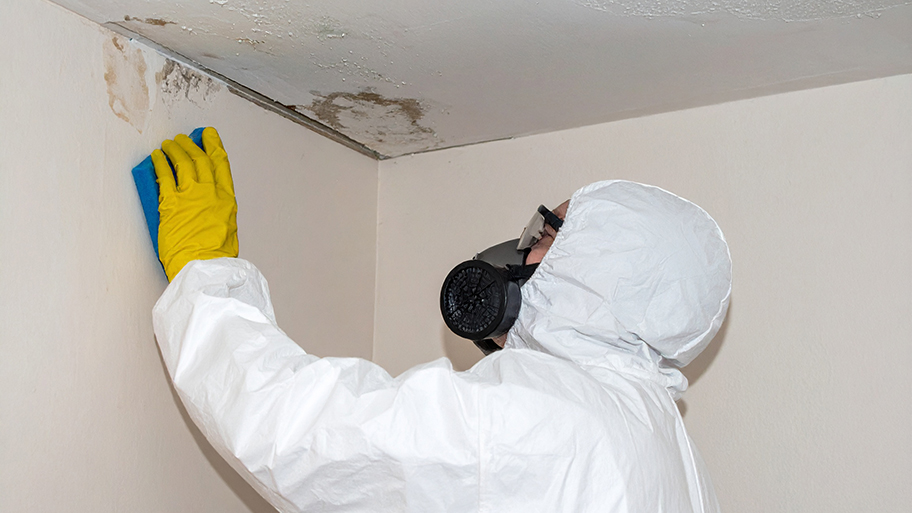
Mold remediation cost can quickly escalate. But if you have mold in your home, the cost for mold remediation is worth it.
The last thing you want is mold ruining your pretty window views


A lack of ventilation and excessive moisture can lead to mold forming on your window sills.
Regular cleaning is key to preventing mold from forming.
When you find mold, you can use a cleaning solution of vinegar and water or hydrogen peroxide and water.
It’s Saturday morning, you finished your latte, and you are ready to roll up your sleeves and get to work. While checking all your cleaning chores off your list, you notice something unseemly growing on your window sills. Could that be mold?
Mold growth on window sills is a common household problem that can lead to various health issues and property damage. Understanding the causes, prevention methods, and effective removal techniques is crucial for maintaining a healthy home environment. In this comprehensive guide, we will explore the reasons behind mold formation, practical tips to prevent its growth, and a step-by-step guide on how to get rid of mold on window sills.
Not sure why mold attacked your poor window sills? Mold on window sills can form due to various reasons:
Excess moisture: Condensation occurs when warm, moist air comes into contact with cooler surfaces like window panes. This moisture provides an ideal breeding ground for mold spores, leading to mold growth on window sills.
Poor ventilation: Inadequate airflow in a room can trap moisture indoors. Areas with poor ventilation, such as bathrooms and kitchens, are particularly susceptible to mold growth on window sills.
Organic materials: Mold requires organic materials, such as dust or wood particles, to grow. Window sills often accumulate dust and debris, providing a food source for mold spores.
Leaking windows: Windows that are not properly sealed or those with existing leaks allow water to seep into the home. This moisture promotes mold growth on and around window sills.

Mold formation on window sills can be a common problem, but with the right preventative measures, it can be effectively managed. Here are some tips to help you prevent mold from forming on your window sills:
Regularly clean your window sills using a mild detergent or a mixture of water and vinegar (yes, something as simple as vinegar does kill mold). This helps remove any dirt, dust, or organic matter that can serve as a food source for mold spores.
Do not mix vinegar with hydrogen peroxide or bleach. Mixing vinegar with hydrogen peroxide creates a toxic chemical that can irritate your skin and eyes. Combining vinegar and bleach can create a toxic chlorine gas.
Adequate ventilation is crucial in preventing moisture buildup. Open windows and use exhaust fans in areas prone to high humidity, such as bathrooms and kitchens. This helps to reduce the amount of condensation that can accumulate on the window sills.
Maintain a relative humidity level between 30% and 50% in your home. Use a hygrometer to monitor humidity levels and consider using a dehumidifier if necessary. High humidity can contribute to mold growth, so keeping it under control is essential.
Inspect your windows regularly for any signs of leaks. Check for damaged seals, cracks, or gaps where water can enter. Repair any leaks promptly to prevent moisture from seeping into the window sills and causing mold growth.
Properly seal your windows with weatherstripping to prevent drafts and reduce the likelihood of condensation forming on the window sills. This helps maintain a more stable environment and minimizes moisture-related issues.
Use mold-resistant materials: Consider using mold-resistant materials when renovating or replacing your windows. Mold-resistant paints, caulks, and sealants can help inhibit mold growth and make cleaning easier.
Proper insulation around windows reduces the chance of cold spots where condensation can form. Insulating window frames and ensuring a tight seal can help prevent moisture accumulation.
Opt for window treatments that allow for airflow, such as blinds or curtains that can be opened during the day. Avoid keeping heavy curtains closed for extended periods as they can trap moisture against the window sills.
By implementing these preventative measures, you can significantly reduce the risk of mold formation on your window sills. Regular maintenance and vigilance in addressing any potential sources of moisture will help keep your windows clean and mold-free.

Mold growth on window sills is not only unsightly but also potentially hazardous to your health, so it’s very understandable if you are eager to get rid of it. Here is a comprehensive step-by-step guide to help you effectively get rid of mold on your window sills.
Collect all the necessary cleaning supplies before you start. You’ll need rubber gloves, safety goggles, a mask to protect yourself from mold spores, a scrub brush, white vinegar or hydrogen peroxide, baking soda, water, a sponge, and paper towels.
Ensure the room is well-ventilated by opening the windows and using fans. Put on your rubber gloves, safety goggles, and mask to protect yourself from mold spores and cleaning agents.
Begin by wiping away loose mold spores, dust, and debris from the window sill using a damp cloth or sponge. Dispose of the cloth carefully to prevent spreading mold spores to other areas.
Mix equal parts of water and white vinegar or hydrogen peroxide in a spray bottle. Remember—never mix vinegar and hydrogen peroxide together. Use one or the other. Alternatively, create a paste by mixing baking soda with a small amount of water. Both solutions are effective against mold and mildew.
Spray the vinegar or hydrogen peroxide solution directly onto the moldy areas of the window sill. Let it sit for about 10 to 15 minutes to penetrate and kill the mold. If you’re using the baking soda paste, apply it directly to the moldy spots.
Use a scrub brush or an old toothbrush to scrub the moldy areas gently. Apply moderate pressure to remove the mold from the surface. For stubborn mold, you might need to repeat this step.
Wipe the window sill with a clean, damp sponge to remove the cleaning solution and the mold residue. Dry the area thoroughly with paper towels to prevent further mold growth. Proper drying is crucial in mold prevention.
After cleaning, consider applying a preventive solution. You can mix water with a few drops of tea tree oil, a natural mold deterrent, and spray it on the window sill. Additionally, ensure proper ventilation and maintain low indoor humidity levels to prevent future mold growth.
Regularly inspect your window sills for signs of mold and promptly address any issues. Keep the area clean and well-ventilated to discourage mold from returning.
Monitor your window sills regularly for any signs of mold resurgence. If the problem persists despite your efforts, it’s best to call a professional mold removal company near you. These pros can assess the situation, identify the root cause, and provide an effective solution. It’s always a good idea to contact a few companies to get an idea of how much you should expect to spend on mold remediation costs.
According to data from Angi customers, 47.5% of homeowners request immediate assistance with mold removal, and 24.4% indicate the timing is flexible. Mold removal isn’t an emergency if it’s in a small area and no one in your home is experiencing any mold-related symptoms.
However, if the mold is widespread, someone in the home is experiencing severe allergy-type symptoms with no other explanation, or you have at-risk people in the house, you should request mold removal as soon as possible.
Raven and crew does absolutely fantastic job. They are very professional if any concerns were to occur with any of her work she always took responsibility and finished out with a great job. I have worked with her business for a year and have always been satisfied. Very trusted business and...
I had Ace Fireplace Services install custom chimney caps for my home, and the results are stunning. They fit like a glove and have added a touch of sophistication to my chimney. I can't recommend their services enough.
Precision and professionalism define Custom Paint Jobs LLC. We couldnt be happier.
Very professional and efficient with work. Answered each question I had with great knowledge and an informative response. Will be working with them again.
Window Depot did an amazing job on my deck. I wasnt sure what I wanted to do, but their composite decking was affordable and will last a long time. I am excited to have family over, and I am no longer embarrassed by my backyard. Jeff and the ground crew were polite, respectful, and caring for...
Great tree company, very professional and honest. Glad we found them, they had the best pricing
We used Unique Hardwood Floor LLC three years ago to work on the floors of a 70 year old home that needed a great deal of work. Some floors needed repairs, some were replaced and others just needed to be refinished. It was a complicated job as they needed to blend the old and the new to...
From average costs to expert advice, get all the answers you need to get your job done.

Mold remediation cost can quickly escalate. But if you have mold in your home, the cost for mold remediation is worth it.

The cost of a mold inspection might seem high, but it’s one of the best investments you can make for your health and home. Read on to learn cost-saving tips.

Tired of an unmistakable odor permeating your living space? Learn how to get rid of a mold smell in your house, and reclaim a clean and odor-free home.

Learning how to remove mold from wood furniture is a worthwhile DIY project because you can save your expensive wood pieces. Learn more about safely removing mold from wood furniture.

These tips will safeguard your home from mold growth after water damage. Protect your house and your health with these expert mold prevention strategies.

Learn how to check for mold after water damage to prevent dangers to your home and health. You should assume that mold is present whenever there is a high-moisture event at your home.